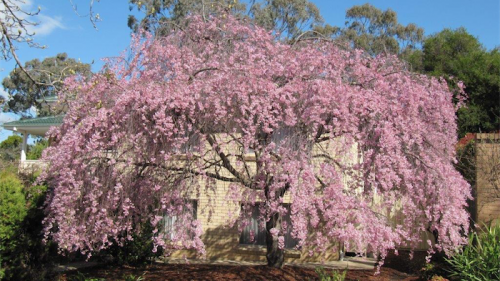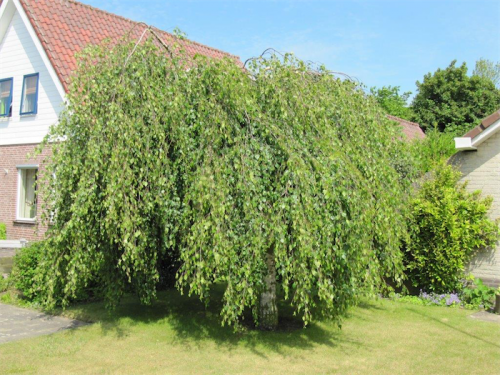
To anyone intending to buy a weeping cherry, please allow it sufficient space to grow naturally. I know of weeping cherries in Canberra growing to a 10-metre spread.
Weeping cherries are the weeping branches grafted on to a standard cherry of various heights. I always prefer the 1.8-metre graft to allow sufficient height for it to grow into its naturally pendulous shape without having to prune every year. A 1.2-metre graft is available, which is suited to growing in a container.
Each variety has different characteristics and pruning methods.
A strong-growing, weeping, spreading tree, the Prunus x subhirtella “Pendula” is always a favourite. Its spectacular show of single, white flowers open in early to mid-spring before the leaves. The size for this cherry will be three metres tall with a five-metre spread in 20 years. This figure can be misleading as the growth obviously depends on the fertility of the soil and, in certain circumstances, it can reach this size in half the time.
The “Pendula Rubra” is slightly larger, five metres by five metres, and also has a prolific show of single, deep-pink flowers.
The Prunus snofozam “Snow Fountain” has a much narrower growth habit. It grows to 2.5 metres tall with just a 1.5-metre spread. It may be more suitable for the ever-decreasing size of suburban gardens.
NOT all flowering, grafted cherries are weeping in habit. Time and again I am asked about Prunus “Shirotae” or Mt. Fuji cherry, a variety that doesn’t weep, but grows in a horizontal, wide-spreading manner. I have seen them with branches tied to lead fishing weights to try and force this tree to weep. Sorry folks, none of these ideas work, it just doesn’t weep.
It still presents a magnificent picture with its slightly pink buds opening into double or semi-double white flowers.

Always think carefully where you intend to grow any weeping tree and check the size in the garden centre before taking it home. The best worst example I’ve seen was two weeping cherries newly planted either side of a front door and just one metre from the door!
IT’S a berry, berry good time to plant all berry fruit. Almost all acid-loving plants, berries are best planted in full sun in soil with plenty of organic matter worked in.
Three such acid-loving berry plants are blueberries, cranberries and loganberries. They all belong to the same family, Vaccinium, and have similar growing conditions. They can all be grown successfully in straight sided containers.
While most blueberries are self-pollinating, it’s advisable to grow more than one variety close to each other to ensure good cropping. Redcurrants, blackcurrants, raspberries, loganberries and gooseberries can all be grown in containers for the small garden.
Jottings…
- Renovate and prune deciduous shrubs such as Philadelphus or Mock Orange. Remember the three “D’s” – remove dead, damaged or diseased branches, which are easy to see when there are no leaves on the shrub.
- Traditionally, the end of August to early September has been the time to prune roses. The thinking has changed and they can be pruned any time, even now. I pruned mine in April and they are looking just fine.
Who can be trusted?
In a world of spin and confusion, there’s never been a more important time to support independent journalism in Canberra.
If you trust our work online and want to enforce the power of independent voices, I invite you to make a small contribution.
Every dollar of support is invested back into our journalism to help keep citynews.com.au strong and free.
Thank you,
Ian Meikle, editor




Leave a Reply